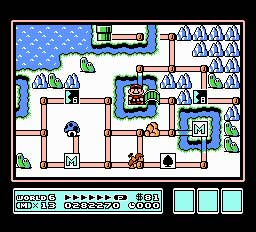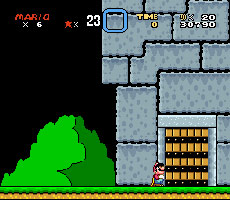|
Editorial: The History of Mario, Part 3Posted on Sun, Jun 20, 2004
Super Mario Bros. 3
Released: 1990
System: NES
If Super Mario Bros. 2 wasn’t quite the true sequel American gamers hoped for, Super Mario Bros. 3 put any possible complaints to rest. SMB3 is, after all, often argued as the best Mario game ever made. What is it about this game that earns it such high regards? It’s a number of reasons, really. Perhaps it is because the game marked a return to the original gameplay style of the first Super Mario Bros. after the radical change in SMB2. Perhaps it’s because the game received a drastic boost in the graphics, making it one of the best-looking NES games of all time. And no doubt it’s because of all the incredibly kooky power ups you could get in the game, ranging from raccoon suits to music boxes. Ultimately, it’s because of all these reasons and more. It was the sum of all its incredible qualities and features, not just one, that made SMB3 such a classic game.
The story treaded on no new ground; it’s that same timeless (and nonsensical) tale of a fair princess being kidnapped from her castle by a lonely and malevolent giant turtle, and of course it’s up to none other than a brave, pudgy plumber to rescue her. It was perhaps by now that gamers started to realize the “Groundhog’s Day” nature of the relationship between Mario, Princess Peach and Bowser—the three of them are perpetually doomed to repeat the same chain of events, over and over (an obvious trend that would eventually be parodied by Nintendo themselves in the Mario RPG series). When games are as good as SMB3, though, rehashed storylines are easily forgiven.
Perhaps the most impressive quality of SMB3, for its time, was its staggering size. The game featured 8 worlds to explore, each filled with not only the regular levels (of which there were over 80), but also many different mini-games that could grant you extra lives. The game was also packed with tons of secrets. There were hidden areas ripe with coins in nearly every level, secret mini-games on the world maps, and even powerful secret items like the Magical Whistle (from The Legend of Zelda, making a cameo appearance here) that let you warp ahead to later worlds.
 SMB3 was also huge in the features department. The game marked the début of many new features in the Mario series, including: new gameplay abilities such as carrying turtle shells and flying with the use of a power-up; new levels with both land and water portions blended together; an world maps with branching paths; the P switches (that turned coins into blocks and vice-versa); the upside-down warp pipes; and an inventory box on the world map that let you store power-ups for later use. Speaking of power-ups, SMB3 has the best line of power-ups ever featured in a video game. How could you go wrong with the raccoon leaf, the frog suit, the hammer bros. suit, and the all-mighty tanooki suit? If you don’t think dressing up like a raccoon and being able to turn into stone is the coolest ability to ever be in a game, then there’s something seriously wrong with you. Another first was the original appearance of Bowser’s seven Koopa Kids, who acted as the end-bosses of each world—but you had to get through the super-cool flying battle ship levels to reach them.
SMB3 was also huge in the features department. The game marked the début of many new features in the Mario series, including: new gameplay abilities such as carrying turtle shells and flying with the use of a power-up; new levels with both land and water portions blended together; an world maps with branching paths; the P switches (that turned coins into blocks and vice-versa); the upside-down warp pipes; and an inventory box on the world map that let you store power-ups for later use. Speaking of power-ups, SMB3 has the best line of power-ups ever featured in a video game. How could you go wrong with the raccoon leaf, the frog suit, the hammer bros. suit, and the all-mighty tanooki suit? If you don’t think dressing up like a raccoon and being able to turn into stone is the coolest ability to ever be in a game, then there’s something seriously wrong with you. Another first was the original appearance of Bowser’s seven Koopa Kids, who acted as the end-bosses of each world—but you had to get through the super-cool flying battle ship levels to reach them.
As a testament to SMB3’s greatness, when it was released the hype surrounding it was so great that Nintendo initially couldn’t make enough copies to quell the demand. To this day, it remains one of the highest selling games of all time; the 1999 Guinness Book of World Records marked it at over 15 million copies sold. After such a crowning achievement, the question then became how Nintendo could possibly follow up such majesty. The answer was simple: new technology and a green dinosaur with an insatiable hunger.
Super Mario World
Released: 1991
System: SNES
In 1992, Nintendo released the sequel to Super Mario Bros. 3, and the game’s title could not have been more fitting; with the increased power of the Super Nintendo, Super Mario World was able to be such an enormous game, with so many secrets and features, that it was like a world onto itself. Although many would suggest that SMB3 was the Mario series at its greatest, just as many believe that title belongs to SMW.
The new technology had no bearing on the plot, though; it was just as charmingly simplistic and goofy as any other plot in a Mario game. Mario and Princess Peach visit the mysterious Dinosaur Island, where Peach is once again kidnapped by Bowser (shocking!). And yes, all of a sudden dinosaurs apparently exist in the Mario universe—which is a good thing, considering the most popular spin-off character to ever come out of the Mario series happened to be a cute green dinosaur named Yoshi, making his début appearance here. Yoshi was, essentially, just another power-up for Mario; he could ride on Yoshi—as if riding a horse—and use his chameleon-like tongue to gobble his enemies. Modest beginnings for what would eventually become one of Nintendo’s biggest franchise characters.
In just about every way, SMW was an evolution of SMB3 (the next great revolution for the series would not come until Nintendo’s third console). The basic gameplay was the same, but significantly expanded and refined. One of the biggest improvements was in the world map; whereas SMB3 only hinted at the possibilities with a few secrets and branching paths in its various world maps, SMW fully realized the inherent potential of the concept. Instead of simply having branching paths every now and then, which would eventually lead to the same place anyway, many individual levels—noted by their red dots on the map—had two end points: the standard exit, and one secret exit in which you had to take a large key to a secret keyhole. Finding the secret exits would lead to entirely different areas and levels on the map, and were the key to finding the “Star Road” that contained shortcuts to much later portions of the game. This also allowed for much more dynamic map locations such as the Forrest of Illusions, which forced you to find the secret exit in many of the levels lest you be doomed to wander around the map in circles forever.
There were, of course, new features in the levels themselves, such as the boxes that would spin instead of break apart when you hit them, the slanted warp pipes that could sometimes shoot you across a small distance, or the variously-colored silhouette boxes that would only become solid once you found the appropriate exclamation point switch in the various switch palaces. Other notable new features were Mario’s spin jump, which allowed him to smash apart the spinning boxes, and the power-up box at the top of the screen, which allowed you to hold a second power-up in case you lost whichever one you currently had. In terms of enemies, SMW marked the first appearance of memorable baddies such as the sport-themed Chargin’ Chucks, the gigantic Banzai Bills, the burrowing Monty Moles, the fire-stomping Sumo Bros., and the caterpillar-like Wigglers. Sadly, SMW also marked the last appearance of Bowser’s seven Koopa Kids that were first seen in SMB3.
 In regards to power-ups, SMW unfortunately eschewed the awesome “suits” concept of SMB3 (which still has never made another appearance in a Mario game). Even so, there were still some cool items such as the feather, which would not only give Mario a swank yellow cape but also granted you the ability to glide in the air indefinitely, so long as you'd perfected your up-drifting technique. Of course, SMW also had Yoshi, who would only go on to bigger and better things. Yoshi was so popular, in fact, that he rocketed from sidekick to star in the very next “Mario game,” which as a result took on a vastly different form.
In regards to power-ups, SMW unfortunately eschewed the awesome “suits” concept of SMB3 (which still has never made another appearance in a Mario game). Even so, there were still some cool items such as the feather, which would not only give Mario a swank yellow cape but also granted you the ability to glide in the air indefinitely, so long as you'd perfected your up-drifting technique. Of course, SMW also had Yoshi, who would only go on to bigger and better things. Yoshi was so popular, in fact, that he rocketed from sidekick to star in the very next “Mario game,” which as a result took on a vastly different form.
Index:
Part 1 - Overview
Part 2 - Super Mario Bros 1 + 2
Part 3 - Super Mario Bros 3 + World
Part 4 - Super Mario World 2 + 64
Part 5 - Super Mario Sunshine
Part 6 - Spin-Offs
Part 7 - Spin-Offs, Continued
Part 8 - Shigeru Miyamoto Biography Posted By: Kris Pigna - 5049 Reads
Go Back |
Features Index |
Post About It
|